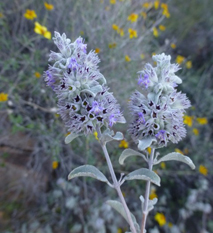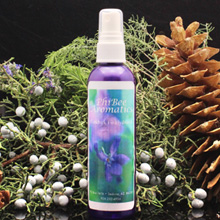DESERT LAVENDER (Hyptis emoryi) Essential Oil
By Clare Licher
 Desert Lavender brings stability to the environment and its inhabitants. The native peoples have treated this plant with reverence, not only for its many healing properties, but for their experience of it as a connection to the spirit world, as it has many ceremonial uses. It was after many years of searching that we finally found enough that we could collect without harming the population, and it is an honor to work with this plant.
Desert Lavender brings stability to the environment and its inhabitants. The native peoples have treated this plant with reverence, not only for its many healing properties, but for their experience of it as a connection to the spirit world, as it has many ceremonial uses. It was after many years of searching that we finally found enough that we could collect without harming the population, and it is an honor to work with this plant.
This herbaceous shrub grows from the low desert up to about a 4,000 foot elevation, in Southern California, Southern Arizona, Southern New Mexico, and Northern Mexico. In the low desert, it grows in the granitic soils of washes and alluvial fans. At higher elevations it grows on the crumbly, rocky slopes of steep canyons. In both of these terrains, its roots provide stability to soils that are vulnerable to erosion. It is interesting to note that in Arizona, it completely surrounds the nuclear power plant.
 Alluvial fans form from mountain run off. In the Southwest we have periodic, torrential monsoon rains that can create flash floods and heavy deposition. An analogy in the human body would be a hemorrhage, or particularly menorrhagia. Desert Lavender has been used by the Native Americans to treat this and other female inflammatory conditions. It does this through its hemostatic and tonifying properties, but also through its stabilizing effects on other body systems, which could be underlying contributors to the menorrhagia.
Alluvial fans form from mountain run off. In the Southwest we have periodic, torrential monsoon rains that can create flash floods and heavy deposition. An analogy in the human body would be a hemorrhage, or particularly menorrhagia. Desert Lavender has been used by the Native Americans to treat this and other female inflammatory conditions. It does this through its hemostatic and tonifying properties, but also through its stabilizing effects on other body systems, which could be underlying contributors to the menorrhagia.
Teas and tinctures of Desert Lavender reduce hyper secretions of the stomach, and are used for treating upper GI tract inflammatory conditions, such as gastric and peptic ulcers, and acid reflux. The tea is also a cleansing antioxidant for the liver, and is helpful for chemical sensitivities, hangover (and other such self-inflicted abuse), and autoimmune dysfunctions. The effect of the tea from this mint family plant is cooling, but not overly cold.
The hydrosol of Desert Lavender hydrosol can be used much in the same way as the tea. It is non toxic, and one teaspoon can be added to a cup of warm water, for a pleasant and refreshing beverage.
Desert Lavender also has a notable effect on the nervous system, calming anxiety (an emotional hemorrhage), tension and insomnia. While it is calming, it is not overly sedating and can be used during the day. One drop of the essential oil, rubbed into the palms and tented over the nose for inhalation, has a stress relieving, centering and grounding effect.
There has been much traditional use of Desert Lavender as a skin healing plant. A GC/MS of Desert Lavender’s essential oil reveals a complex chemistry of 166 constituents. It is surprisingly high in monoterpenes, with several monoterpenols and a constellation of 27 sesquiterpenols. While the latter may be minor components, it is undoubtedly some of these unusual constituents that give it such a broad range of soothing therapeutic effects. The anti-microbial and anti-inflammatory properties of this essential oil make it suitable for healing cuts, scrapes, burns, rashes and insect bites (our daughter is a mosquito magnet, and it has provided her with great relief!).
The aroma is complex. It has a top note that is reminiscent of Lavender, a sweet, honey-like middle note, and an earthy, peppery base note. This complexity can be seen visually in the distillation process. When the distillation is complete the top of the oil is a clear, pale yellow, the middle is a more opaque yellow, and the bottom is a bright amber color. The yield is moderate, ranging between .4% and .55%.
This plant must be treated with care. It is not suitable for large scale commercial production, because it is very slow growing and generally does not cooperate well with cultivation. Even one year of over-harvesting could have devastating consequences for the plant and it’s environment.
Purchase Desert Lavender Essential Oil here
References
Daniel E Moerman, (2009), Native American Medicinal Plants, an Ethnobotanical Dictionary
Michael Moore, (1989), Medicinal Plants of the Desert and Canyon West.
Charles Kane, (2006), Herbal Medicine of the American Southwest
Desert Tortoise Botanicals, Sonoran Plant Profile – Desert Lavender
www.desertortoisebotanicals.com


